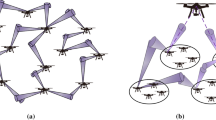Abstract
Wireless solar blind ultraviolet (UV) scattering communication is a new type of atmosphere optics communication technology with the important and potential advantages of all-weather, non-line-of-sight and secret communication, which is suitable for the needs of cluster security of Unmanned Aerial Vehicle (UAV) formation flight. UV communication technology can be applied to share UAVs status information, combined with efficient formation control method can achieve autonomous assembly, collision avoidance and formation keeping in UAV formation flight. In order to avoid the collision avoidance problem between the UAVs in the classic formation control algorithm. In this paper, the artificial potential function of the formation control algorithm is improved and the improved algorithm is applied to a single virtual leader UAV and multi-virtual leader UAVs. The simulation results show that the algorithm can ensure that the UAVs speed in the formation is consistent with the speed of the virtual leader UAV. In the course of the flight, the UAVs can avoid collision. Finally, the formation flight is completed with the desired formation.












Similar content being viewed by others
References
Hexmoor, H., Rahimi, S., & Little, J. T. (2009). Coordinated UAV manoeuvring flight formation. Informatica, 33(3), 375–383.
Ermentrout, G. B., & Edelsteinkeshet, L. (1993). Cellular automata approaches to biological modeling. Journal of Theoretical Biology, 160(1), 97–133.
Parrish, J. K., & Edelsteinkeshet, L. (1999). Complexity, pattern, and evolutionary trade-offs in animal aggregation. Science, 284(5411), 99–101.
Li, W. (2015). Persistent surveillance for a swarm of micro aerial vehicles by flocking algorithm. Proceedings of the Institution of Mechanical Engineers Part G Journal of Aerospace Engineering, 229(1), 185–194.
Ren, W., Chao, H., Bourgeous, W., et al. (2008). Experimental validation of consensus algorithms for multivehicle cooperative control. IEEE Transactions on Control Systems Technology, 16(4), 745–752.
Mahmoud, M. S., Pirovano, A., & Larrieu, N. (2014). Aeronautical communication transition from analog to digital data: A network security survey. Computer Science Review, 11(12), 1–29.
Drost, R. J., Moore, T. J., & Sadler, B. M. (2013). Ultraviolet scattering propagation modeling: Analysis of path loss versus range. Journal of the Optical Society of America A. Optics and Image Science, 30(11), 2259–2265.
Reynolds, C. W. (1987). Flocks, herds and schools: A distributed behavioral model. In Conference on computer graphics and interactive techniques. Computer graphics (pp. 25–34).
Olfati-Saber, R. (2006). Flocking for multi-agent dynamic systems: algorithms and theory. IEEE Transactions on Automatic Control, 51(3), 401–420.
Tanner, H. G., Jadbabaie, A., & Pappas, G. J. (2007). Flocking in fixed and switching networks. IEEE Transactions on Automatic Control, 52(5), 863–868.
Su, H., Wang, X., & Lin, Z. (2009). Flocking of multi-agents with a virtual leader. IEEE Transactions on Automatic Control, 54(2), 293–307.
Xiang, M., Zhang, H., & Wang, Y. (2018). Flocking of quad-rotor UAVs with fuzzy control. Isa Transactions, 74, 185–193.
Yan, M. D., Zhu, X., Zhang, X. X., et al. (2017). Consensus-based three- dimensional multi-UAV formation control strategy with high precision. Frontiers of Information Technology & Electronic Engineering, 18(7), 968–977.
Acknowledgements
This work was supported by Natural Science Foundation of China-Civil Aviation Administration of China Joint Research Fund (No. U1433110), Shaanxi key industrial chain innovation project (No.2017ZDCXL-GY-06-01, 2017ZDCXL-GY-05-03), Shaanxi province industrial science and technology breakthrough project (No. 2016GY-082), Scientific Research Program Funded by Shaanxi Provincial Education Department (No. 17-JF024) and Fund of Robot Technology Used for Special Environment Key Laboratory of Sichuan Province (No. 17kftk04). We also would like to thank the anonymous reviewers for their comprehensive reviews and comprehensive feedback.
Author information
Authors and Affiliations
Corresponding author
Additional information
Publisher's Note
Springer Nature remains neutral with regard to jurisdictional claims in published maps and institutional affiliations.
Rights and permissions
About this article
Cite this article
Zhao, T., Xie, Y., Xu, S. et al. Flocking of UAV Formation with Wireless Ultraviolet Communication. Wireless Pers Commun 114, 2551–2568 (2020). https://doi.org/10.1007/s11277-020-07489-7
Published:
Issue Date:
DOI: https://doi.org/10.1007/s11277-020-07489-7




